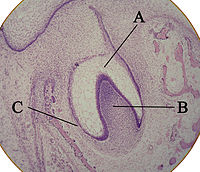
Photo from wikipedia
Ameloblastoma, the most clinically significant odontogenic epithelial tumor, is a locally-invasive and destructive lesion in the jawbones. However, the nature of this infiltrativeness and destructive behavior remains ill-understood. To address… Click to show full abstract
Ameloblastoma, the most clinically significant odontogenic epithelial tumor, is a locally-invasive and destructive lesion in the jawbones. However, the nature of this infiltrativeness and destructive behavior remains ill-understood. To address this, we established an in vitro three-dimensional (3D) co-culture system to simulate an amelobastoma disease model aimed at investigating the interactions between tumor cells and osteoblasts. Osteoblastic cell lines (KUSA/A1 and MC3T3-E1) and one stromal cell line (ST2) were separately co-seeded with ameloblastoma-derived cell line (AM-1) in a collagen scaffold (representing the extracellular bone matrix) and incubated with mineralization medium. Immunohistochemistry, double immunofluorescence and mineralization assay were performed. Only AM-1/KUSA-A1 co-culture showed a significant increase in AM-1 cell count, suggesting that heterotypic cell-cell interaction promotes tumoral cell growth, while formation of visible AM-1 epithelial nest-like structures resembling ameloblastoma cells in their native state, suggest morphodifferentiation. A RANK-high, RANKL-low and osteoprotegerin-low immunoprofile in co-culture AM-1 cells implies deregulated osteoclastogenesis. Mineralization assays showed diminished calcification in AM-1/KUSA-A1 co-culture extracellular matrix suggesting an altered local bone metabolism. In contrast, KUSA/A1 monocultures showed abundant extracellular matrix calcification. Taken together, these results suggest that a 3D co-culture system as an amelobastoma disease model provides insights that bidirectional ameloblastoma-osteoblastic interactions might play a role in modulating tumor growth and osteoclastogenesis.
Journal Title: Sains Malaysiana
Year Published: 2019
Link to full text (if available)
Share on Social Media: Sign Up to like & get
recommendations!